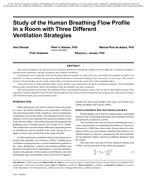Description
This study investigates the characteristics of human exhalation through the mouth with three different ventilation strategies: displacement ventilation, mixing ventilation and without ventilation. Experiments were conducted with one breathing thermal manikin in a full scale test room where the exhalation airflow was analyzed. In order to simulate the gaseous exhaled substances in human breathing, N2O was used as a tracer gas. The concentration of N2O and the velocity of the exhaled flow were measured in the center line of the exhalation flow. The velocity decay of the exhalation flow versus distance was analyzed for the three ventilation strategies. The relationship between gas concentration values and distance from the manikin was also examined. The measurements showed that the exhalation flow of breathing depends to some extent on the air distribution system. Two equations could be applied to describe the relationship between distance from the manikin and, respectively, peak velocity values and maximum mean gas-concentration values.
Citation: IAQ Conference: IAQ 2010: Airborne Infection Control
Product Details
- Published:
- 2011
- Number of Pages:
- 7
- File Size:
- 1 file , 620 KB
- Product Code(s):
- D-IAQ2010-C93




